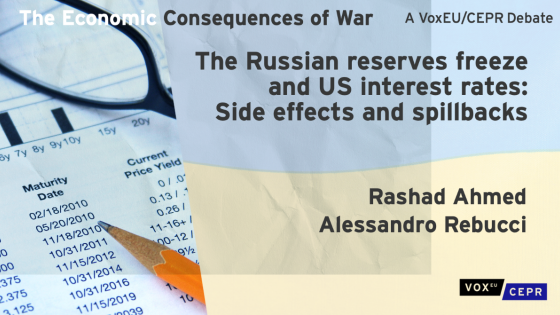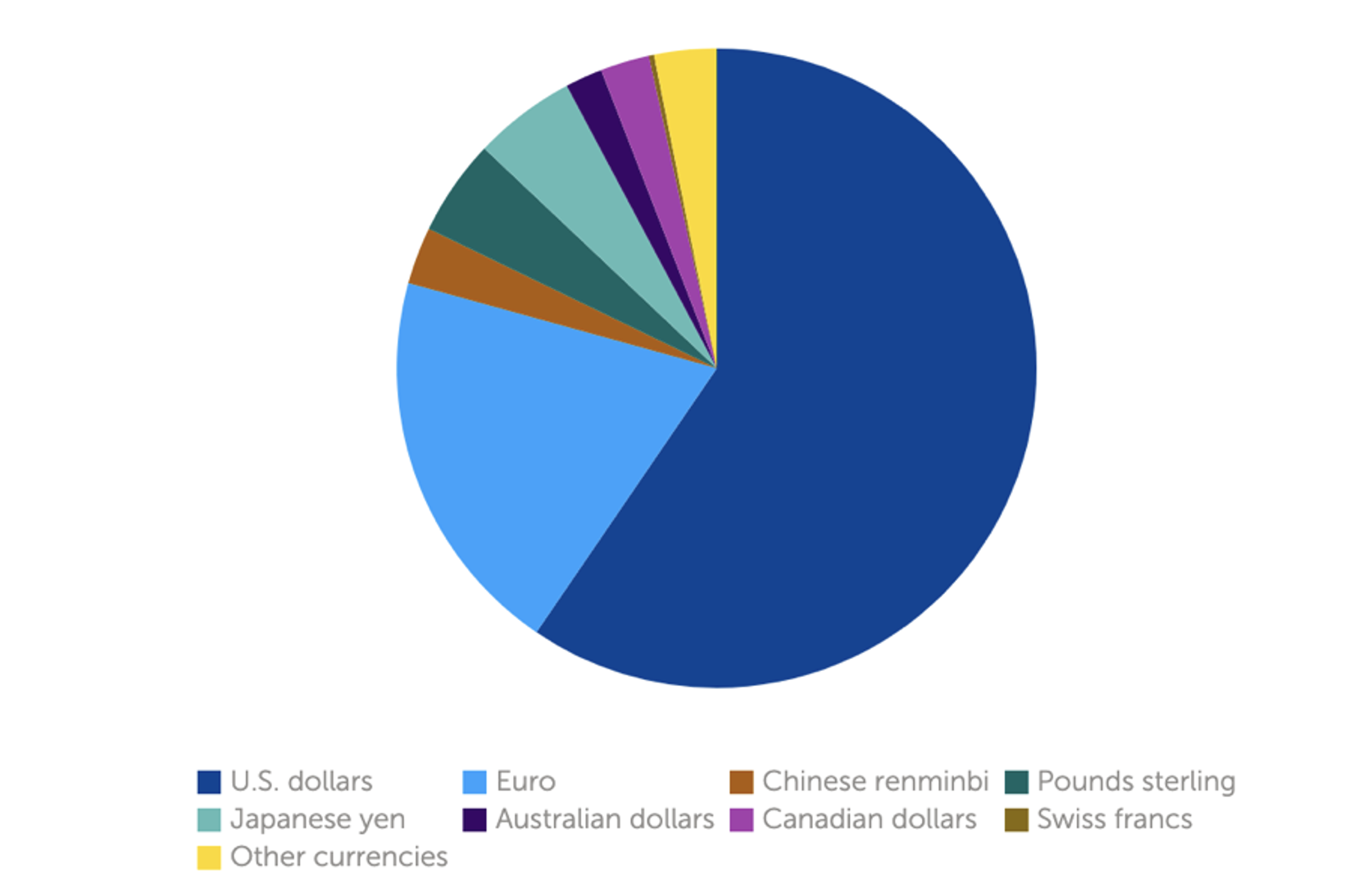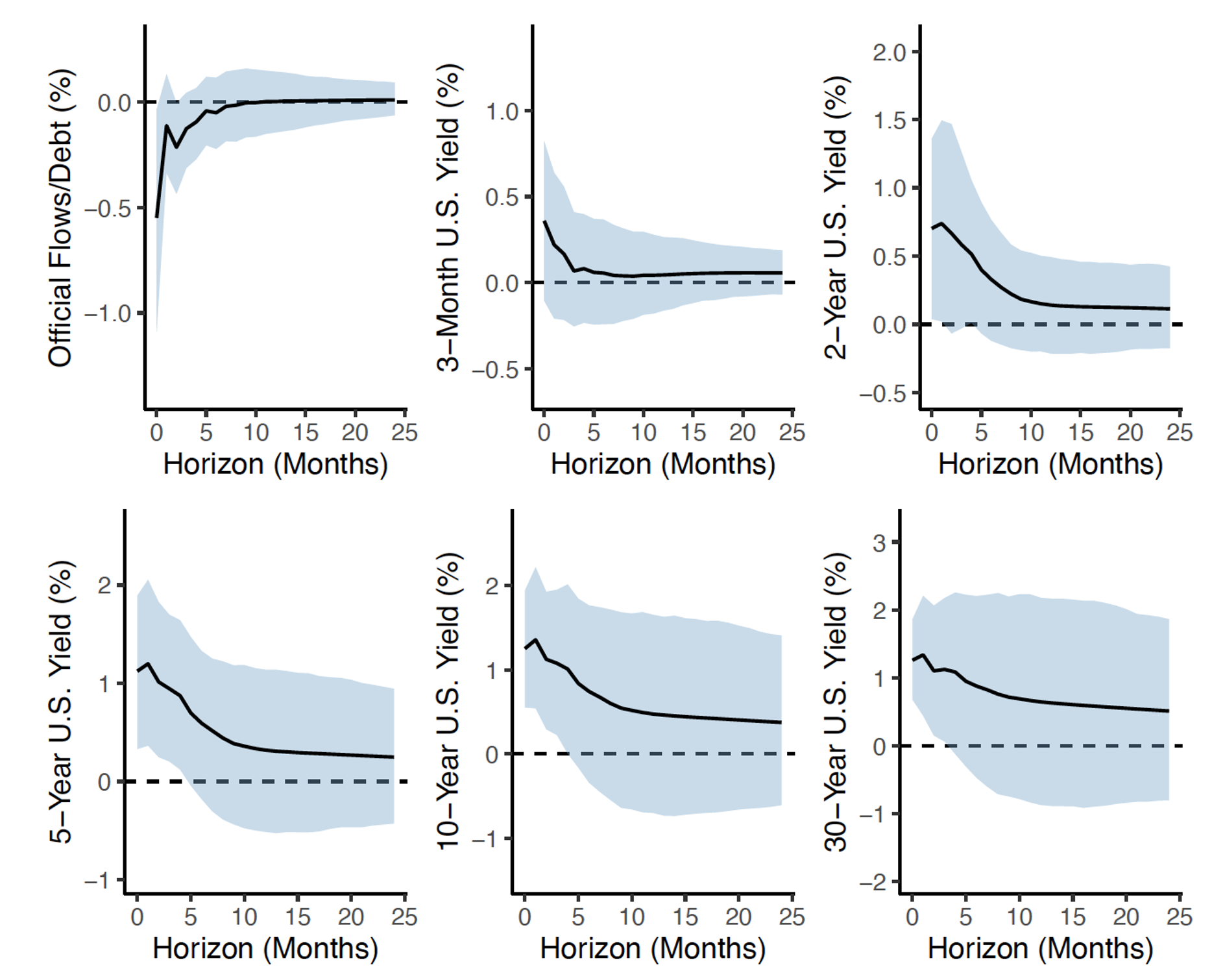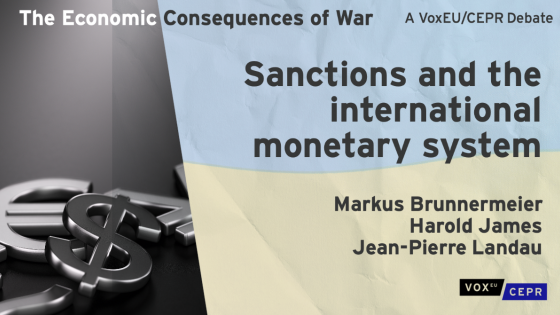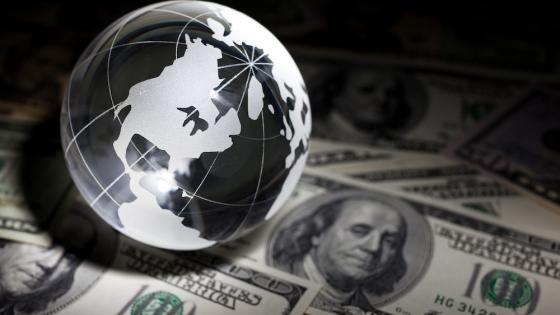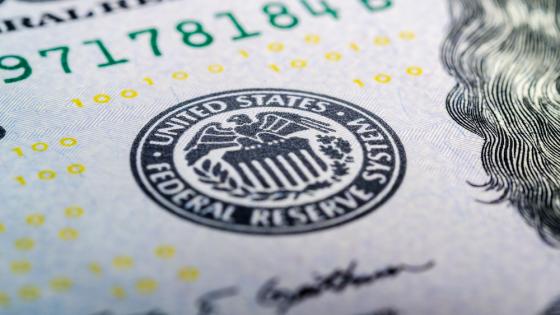Editors' note: This column is part of the Vox debate on the economic consequences of war.
The Russian invasion of Ukraine triggered unprecedented financial sanctions, including the freezing of Russia’s official reserves. Whether or not countries can diversify their reserves away from the US dollar or whether the ongoing geopolitical tensions will push the world economy toward a new system of insular regional blocks in which foreign reserves no longer serve their main purpose remain open questions (Harding 2022, The Economist 2022). However, the sudden realisation that official reserve holdings are exposed to sanction risk has undoubtedly diminished the insurance value of this financial war chest, at least for countries that face such a low-probability but high-cost threat (Brunnermeier et al. 2022).
Figure 1 Currency composition of global foreign exchange reserves
Source: IMF COFER Database.
While most global foreign exchange reserves (59.53% in Figure 1) remain in dollars, the sanctions on Russia were imposed on the backdrop of a trend decline in the dollar’s share since 1999 (Arslanalp et al. 2022) and some erosion of the convenience yield of US Treasury securities (Chen et al. 2022). Going forward, therefore, it is plausible to anticipate some compositional changes in favour of physical gold holdings, strategic reserves of energy and other scarce commodities, and perhaps crypto assets, or at least a continued gradual decline in the share of dollar assets in favour of other currencies.
One direct consequence of a shift away from global US dollar dominance is lower foreign demand for US Treasury securities (UST). In Ahmed and Rebucci (2022), we examine how shifts in US Treasury securities demand from foreign official institutions impact US Treasury yields. We find that long-term yields temporarily rise by roughly 100 basis points for every $100 billion Treasury securities sold by foreign officials, with a long run effect of about 30 basis points.
Figure 2 Impulse response of US yields to a $100 billion foreign official sale shock
Source: Ahmed and Rebucci (2022)
In Figure 2, the black solid line displays the impulse responses to a negative foreign official US Treasuries demand shock scaled to equal a $100 billion sale of US Treasuries. The shaded blue regions are one standard deviation confidence bands. The upper-left panel traces the path of foreign official Treasury securities flows, consistent with a Treasury securities sale shock. The remaining panels trace out the response of US Treasury yields of different maturities.
Our estimates, and particularly the short-run impact that is most relevant for Treasury market liquidity, are substantially larger than the 13-68 basis point range reported across earlier studies. While our estimates build on those such as Warnock and Warnock (2009) and Wolcott (2020), they differ in two distinct ways. First, our estimates do not rely on the assumption of price-inelastic foreign official flows. Second, we account for the fact that US Treasury yields are determined by global factors and Fed policy in addition to demand from foreign central banks and other domestic factors.
Estimating the causal effect of foreign official US Treasury securities flows on US yields is challenging because of the potential simultaneity between quantities and prices. To deal with this simultaneity problem, we estimate a structural vector autoregression (VAR) of short-term and long-term Treasury yields identified via heteroskedasticity (Rigobon 2003, Lewis 2022, Brunnermeier et al. 2021), exploiting the change in the volatility of international capital flows and US yields following the 2008 Global Crisis. Using the VAR model estimated on monthly data from 1999 to 2018, we then simulate how an exogenous foreign official sale of US Treasuries (as a percentage of marketable Treasury debt outstanding) impacts US Treasury yields.
Our VAR model not only controls for domestic fundamentals such as current and expected US GDP growth and inflation rates, US fiscal balances, and risk appetite, but also accounts for unconventional Fed policies and foreign yields that can be omitted confounders. In fact, Fed policy is countercyclical, and foreign yields are associated with global growth prospects (Figure 3) that in turn comove with official demand for dollar reserves through foreign exchange intervention and precautionary demand for US Treasuries. This foreign term-spread also comoves with foreign official flows, and to some extent also with domestic components of US Treasury demand as Figure 4 illustrates.
Figure 3 Correlations between foreign yields and global output growth
Source: Ahmed and Rebucci (2022).
Figure 4 Correlations between foreign yields and US treasury securities flows by investor segment
Source: Ahmed and Rebucci (2022).
The impact of a sudden reduction in dollar reserves held by foreign central banks
Consider now the implied short-run price impact of a hypothetical reduction in central bank holdings of US dollar-denominated assets by 1%. Consider for instance China, a major official holder of US dollar assets, and a medium-sized holder like Saudi Arabia. Over the last two decades, China operated a fixed exchange rate regime first which was followed by a managed float, accumulating a massive war chest of official reserves, with reported total official reserves (excluding gold) of $3.25 trillion as of March 2022, and nearing $4.0 trillion if we include the foreign assets of state banks. Saudi Arabia has long operated a hard peg to the dollar and is the largest oil exporter. Its official reserve holdings are estimated at $326 billion in March 2022.
In the case of China, a 1% shift away from dollar reserves amounts to a -$19.5 billion outflow.
Using the estimated contemporaneous impact from Figure 3 above of 1.12 and 1.25 basis points per $1 billion flows, five-year and ten-year yields could rise by 21.8 and 24.4 basis points, respectively, in the short-run. Thus, the impact is comparable in magnitude to the effects of a round of Fed quantitative easing (QE) (Rebucci et al. 2022) or to the 22 September Japan foreign exchange intervention of $20 billion that coincided with a 20 basis points increase in US yields. In contrast, the same 1% reallocation by Saudi Arabia only results in a -$2 billion outflow, implying the five-year and ten-year yields would rise by 2.2 and 2.5 basis points, respectively.
A reduction of the US dollar share of reserves in medium-sized holders like Saudi Arabia would be easily absorbed by the US Treasury securities market. However, if China were to shift its reserve composition away from the dollar it might have a much stronger short-run impact. In the current context of continued warfare in Ukraine, broader geopolitical tensions with Russia and China, increasing US policy rates, dollar strength, and relatively illiquid government debt markets such a move might indeed prove quite disruptive and trigger another dash for dollars as we saw in March 2020.
References
Ahmed, R and A Rebucci (2022), "Dollar Reserves and U.S. Yields: Identifying the Price Impact of Official Flows", CEPR Discussion Paper 17599.
Arslanalp, S, B Eichengreen and C Simpson-Bell (2022), "The stealth erosion of dollar dominance and the rise of nontraditional reserve currencies", Journal of International Economics 138(103656).
Brunnermeier, M K, H James and J-P Landau (2022), "Sanctions and the international monetary system", VoxEU.org, 5 April.
Brunnermeier, M, D Palia, K A Sastry and C A Sims (2021), "Feedbacks: financial markets and economic activity", American Economic Review 111(6): 1845-79.
Chen, Z, Z Jiang, H Lustig, S Van Nieuwerburgh and M Z Xiaolan (2022), “Exorbitant Privilege Gained and Lost: Fiscal Implications”, NBER Working Paper No. 30059.
Harding, R (2022), “Toppling the Dollar as Reserve Currency Risks Harmful Fragmentation”, Financial Times, 10 March.
Lewis, D J (2022), "Robust inference in models identified via heteroskedasticity", Review of Economics and Statistics 104(3): 510-524.
Rigobon, R (2003), "Identification through heteroskedasticity", Review of Economics and Statistics 85(4): 777-792.
Rebucci, A, J S Hartley and D Jiménez (2022), "An event study of COVID-19 central bank quantitative easing in advanced and emerging economies", in A Chudik, C Hsiao and A Timmermann (eds), Essays in Honor of M. Hashem Pesaran: Prediction and Macro Modeling, Emerald Publishing Limited.
The Economist (2022), “Can Foreign-Currency Reserves Be Sanction-Proofed?”, 19 March.
Warnock, F E and V C Warnock (2009), "International capital flows and US interest rates", Journal of International Money and Finance 28(6): 903-919.
Weiss, C R (2022), "Foreign Demand for US Treasury Securities during the Pandemic", FEDS Notes, 28 January.
Wolcott, E L (2020), "Impact of foreign official purchases of US Treasuries on the yield curve", AEA Papers and Proceedings 110.
Vissing-Jorgensen, A (2021), "The treasury market in spring 2020 and the response of the federal reserve", Journal of Monetary Economics 124: 19-47.
